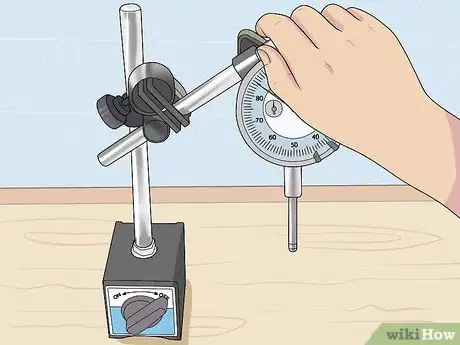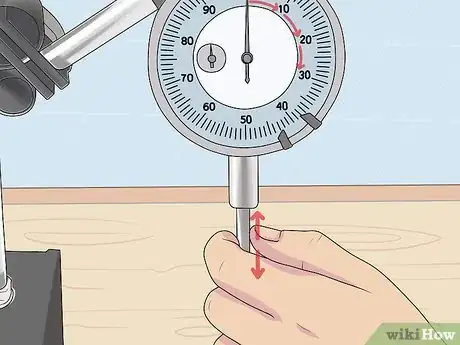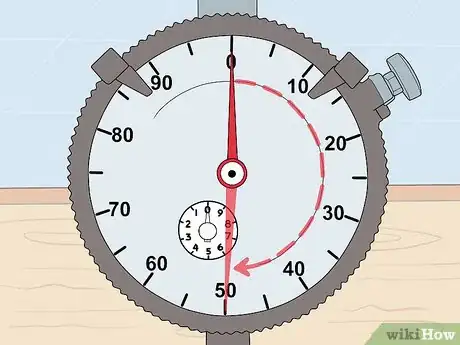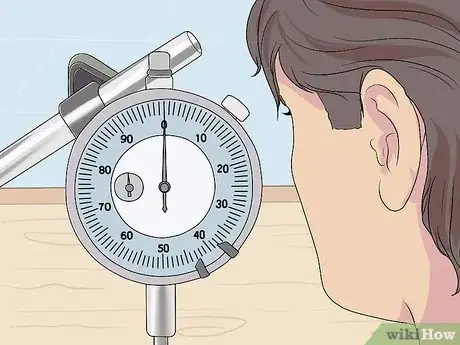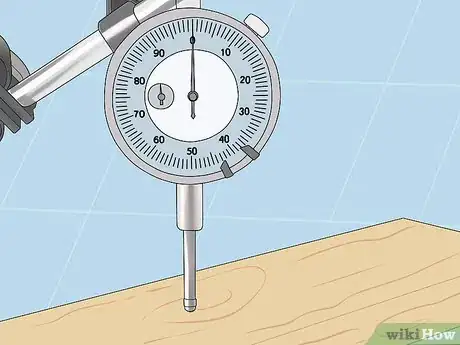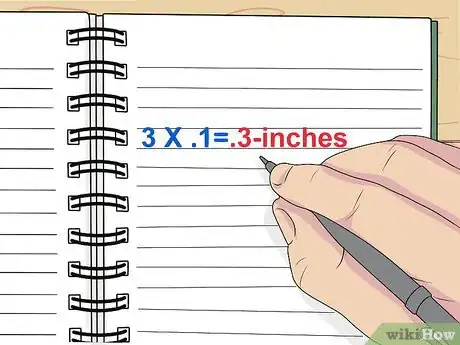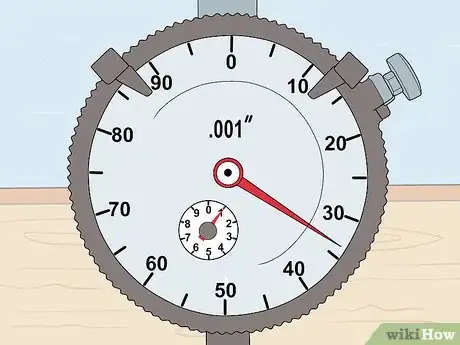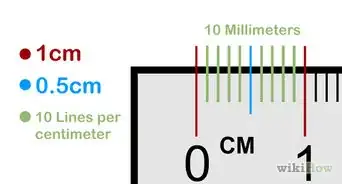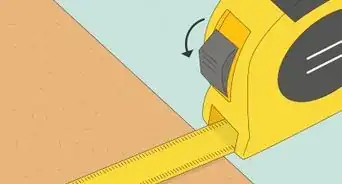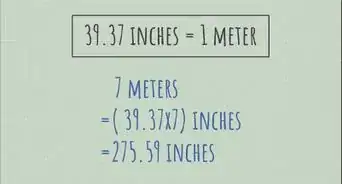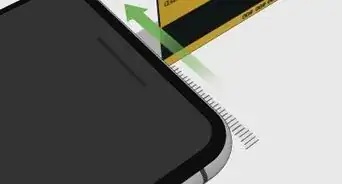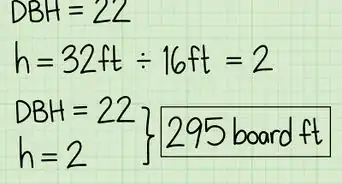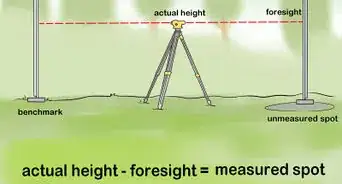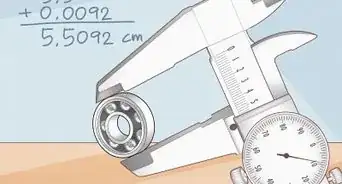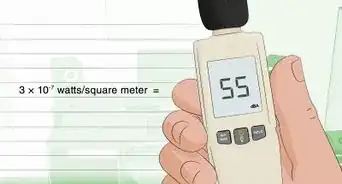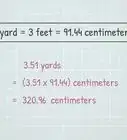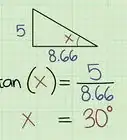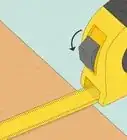This article was co-authored by wikiHow staff writer, Danielle Blinka, MA, MPA. Danielle Blinka is a Writer, Editor, Podcaster, Improv Performer, and Artist currently living in Houston, TX. She also has experience teaching English and writing to others. Danielle holds a Bachelor of Arts in English, Bachelor of Arts in Political Science, Master of Arts in English with a concentration in writing, and Master of Public Administration from Lamar University.
This article has been viewed 299,099 times.
Learn more...
Dial indicators can be used to check round parts like wheels for straightness and are commonly used in machine shops. While the dials may seem confusing at first, they’re easy to read once you understand what they mean. It’s easy to read a dial indicator if you calibrate your dial indicator, understand the parts of a dial indicator, and take a measurement.
Steps
Calibrating Your Dial Indicator
-
1Mount your dial indicator on a stand. Your dial indicator should have an attachment that you can use to secure it to a stand. The stand will stabilize your dial indicator while you take your measurements.[1]
- If you do not have a stand, it is still possible to calibrate your dial indicator, but it will not be as easy.
-
2Turn the outer dial face until the hand points to 0. The outer dial face can be moved by twisting the rim of the dial. Spin the outer face until the hand hovers over zero. Your calibration measurements will ensure that the dial indicator does read measurements starting at zero.[2]
- If you discover errors, you will be able to correct for them by readjusting the outer face so that the hand hovers over the zero point.
Advertisement -
3Begin displacing your spindle. Stop at every 1/10 measurement to calculate errors. Continue to check for errors at 1/10 measurements for the first two revolutions of your dial.[3]
-
4Check for errors at half revolutions. For the next five revolutions, stop at every half revolution to calculate for errors, rather than at the 1/10 mark.
- If your dial indicator makes more than seven revolutions, check for errors at every revolution after your reach seven.[4]
- Do not let go of the spindle because you will need to check for errors in the reverse.
-
5Begin to reverse your revolutions. Follow the same error-checking procedure, but in reverse. Check the measurement at each of the same points, so for the first five revolutions you will stop at the half revolution to measure. Then check the measurement at the 1/10 marks for the remaining two revolutions.[5]
-
6Take five measurements of the same item. Displace the spindle five times using the same surface. Move the spindle quickly for some measurements and slowly for others. Write down each of the five measurements to check for deviations. Because you’re measuring the same surface repeatedly, each measurement should come out the same if your dial indicator is ready to use.[6]
- If your dial indicator is showing errors, adjust the outer face and clean the spindle. Dust can accumulate on the spindle and cause issues with taking measurements. Repeat the calibration process until there are no errors.
Identifying the Parts of a Dial Indicator
-
1Look at the faces on your dial indicator. The hands will move when you press the spindle at the bottom of your gauge. The outer face, which can be turned by twisting the outer rim of the face, takes the smaller measurements, usually in one-thousandths. The inner face, which is small and stationary, keeps track of the number of revolutions.[7]
- Some dial indicators may have more than one face. If yours does, consult the instruction documents for more information about the extra faces.
- Your manufacturer will also print the range of measurements on either your dial indicator or the instructions that come with it. They commonly measure from .001-1.0 inch.
-
2Measure how long your spindle is. The spindle extends from the bottom of your gauge and is used to take the measurements. To take a measurement, you will press it against what is being measured. The length of the spindle that can be inserted into the gauge during the measurement will correspond with the measurement that appears on the dial face.[8]
-
3Identify the measurement marks. You should see 100 marks on the larger face that represent .001 inches. The length of your spindle and number of revolutions that the hand makes on the larger face when the spindle is fully inserted will determine how the marks on the small face are measured.
- For example, if you can insert your 1-inch long spindle for 10 revolutions, then each revolution measures .1-inches.[9]
Taking a Measurement
-
1Press the spindle against the item to be measured. To take a measurement, you will need to displace space on your spindle. Align the base of the spindle with the item to be measured. Push the dial indicator against the item, counting the number of revolutions made to double-check your accuracy. Hold the gauge in place to take your measurement.[10]
-
2Count the marks displaced on the small gauge. Depending on how your small gauge is labeled, it could count just your revolutions or track the measurement. Take down the number of revolutions or the measurement itself if it's printed on the gauge.[11]
- If the dial indicator did not make at least one revolution, then skip to reading the large gauge because the small gauge only matters if the indicator makes at least one full revolution.
-
3Calculate the measurement. If your small gauge shows revolutions or does not provide a clear measurement, take the number of marks displaced and multiply it by the length that is represented by one revolution.[12]
- For example, if one revolution equals .1-inches, then you would calculate three marks on the small gauge as 3 X .1=.3-inches.
-
4Count the marks displaced on the large gauge. The big outer face should be marked with 100 notches. Most dial indicators will be labeled at the 5’s or 10’s to make it easier to read. Determine which marker the hand best lines up with, then take down the number.
- Make sure that you count if the gauge makes complete revolutions. For example, it may completely circle once and then land on the notch next to 30. Remember to add the calculations from both the small and large gauges.[13]
-
5Calculate the measurement. Remember that the larger gauge represents a smaller measurement, so while the small gauge might measure in tenths, the outer gauge measures in thousandths. If the hand is pointing at 30, then it means 30 thousandths.[14]
- To calculate the measurement, divide the number by 1,000. For example, 30/1000=0.030-inches.
-
6Add the two calculations together. Take both the small gauge and large gauge measurements and add them together. In the examples above, you'd have 0.3+0.030=0.330-inches. This is your reading from the dial indicator.
Community Q&A
-
QuestionWhich part is the main scale in a dial gauge?
 Community AnswerThe outer face, which can be turned by twisting the outer rim of the face, which takes the smaller measurements, usually in one-thousandths. The inner face, which is small and stationary, keeps track of the number of revolutions.
Community AnswerThe outer face, which can be turned by twisting the outer rim of the face, which takes the smaller measurements, usually in one-thousandths. The inner face, which is small and stationary, keeps track of the number of revolutions. -
QuestionWould 0.30 be 30 on the large dial?
 ROBERTO JACOBOCommunity AnswerNo. 0.30 would be 3 on the small dial and 0 on the large dial. If you are getting a reading of 0 on the small dial and 30 on the large dial, the reading would be 0.030.
ROBERTO JACOBOCommunity AnswerNo. 0.30 would be 3 on the small dial and 0 on the large dial. If you are getting a reading of 0 on the small dial and 30 on the large dial, the reading would be 0.030.
References
- ↑ https://www.youtube.com/watch?v=TrRcEg0NB9A
- ↑ https://www.youtube.com/watch?v=TrRcEg0NB9A
- ↑ https://www.mitutoyo.co.jp/eng/products/menu/QuickGuide_Dial-Indicators.pdf
- ↑ https://www.mitutoyo.co.jp/eng/products/menu/QuickGuide_Dial-Indicators.pdf
- ↑ https://www.mitutoyo.co.jp/eng/products/menu/QuickGuide_Dial-Indicators.pdf
- ↑ https://www.mitutoyo.co.jp/eng/products/menu/QuickGuide_Dial-Indicators.pdf
- ↑ https://www.youtube.com/watch?v=TrRcEg0NB9A
- ↑ https://www.youtube.com/watch?v=TrRcEg0NB9A
- ↑ https://www.youtube.com/watch?v=TrRcEg0NB9A
About This Article
To read a dial indicator, start by mounting it on a stand to stabilize it and calibrating the dial by turning the outer face until the hand points to 0. Once the dial indicator is calibrated, press the spindle on the bottom against the item you’re measuring. Next, count the marks displaced on the small and large gauges by looking where the hand is pointing. Then, add the two measurements together to determine the final dial indicator reading. For help identifying the measurement marks on the indicator face, read on!
